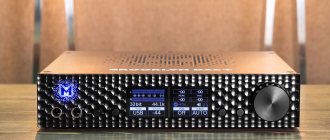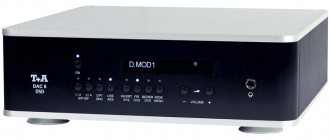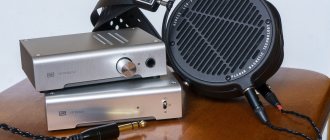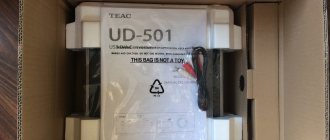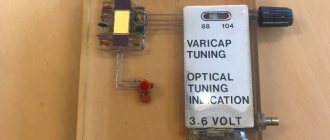Finally we got to a full-size device from Mytek. The previously reviewed Liberty DAC and Brooklyn DAC+, despite all the seriousness of the equipment, did not look like a full-format component. Cases a third or half the standard width - is that solid? The Mytek Manhattan DAC II is a completely different matter! And the manufacturer itself positions it as an exclusively high-end home device. And of the entire trio of Maiteks, only the eldest will look natural in a rack with classic Hi-Fi. It remains to be seen how it can attract audiophiles and whether it is very different from its professional colleagues.
Elitism
Elitism is the word that fully characterizes the Mytek Manhattan DAC II. No matter what you touch, where you don’t look, you will encounter only the most top-notch, the best and the most modern.
It all starts with the older Saber 9038Pro chip, which provides a record dynamic range of 130 dB. The Femto Clock keeps jitter levels below 1 ps. There is also a clock output for transport synchronization and an input for using a single external oscillator. In DoP mode, the device supports DSD128 via a dual-channel SPDIF connection. There are two volume controls, one better than the other: a high-precision 32-bit digital with 1 dB steps and a precision analogue one, which is built on a resistor matrix with relay switching.
The built-in headphone amplifier has zero output impedance and good current reserve, delivering up to 6 W of power - depending on the load impedance. Native DSD support, MQA hardware decoding, and the ability to play DXD are self-evident things that are not usually asked about in such a situation.
And there is no need to ask rhetorical questions about where and how to try it all on. Indeed, some of the technologies and sky-high numbers may not be useful and may not go beyond the scope of the experiment. Do you have a lot of DXD in your collection and are you planning on sending DSD over PCM over two SPDIF cables instead of sending the native DSD stream over USB? But the other and clearly larger half of the solutions and technologies mentioned is precisely what distinguishes High End from the bulk of good and even very good devices.
Not mentioned above, but quite classic features of High End, without which not a single elite device can do, can also include a linear power supply, assembled on the basis of two shielded toroidal transformers with separate stabilized lines for each functional unit and large capacitor banks, as well as aluminum housing with two types of vibration decoupling supports included in the kit.
Review. Mytek Manhattan DAC II. Fifty shades of expressiveness
I have been familiar with Mytek DACs for a long time, so I took up testing their new flagship, the Manhattan DAC II, with interest. Moreover, at one time I managed to get acquainted with its predecessor - the first generation Mytek Manhattan. But the new product is similar only in the case and power supply system, and the main board has been completely redesigned. The new DAC is built on the well-known ESS Saber 9038 chip.
We can say that the DACs on various versions of Saber are a little unlucky, and good examples unfairly suffer from a certain generalized reputation that this chipset has earned. The ease of implementation and high characteristics of the chip prompted many manufacturers to produce a variety of inexpensive products, which, upon closer examination, turned out to have a whole bunch of shortcomings, among which I would first of all highlight the unnaturally lush, “ornate” sound, excessively silvery, disembodied high frequencies and an empty range from the upper middle and above. The latter is generally the scourge of modern digital products; obviously, such a presentation in our age of pursuit of high resolution allows us to mask creative impotence when trying to master modern Hi-Res formats. The chipset turned out to have a catch: it turned out that in order to extract a really cool sound you have to work hard on all fronts: in terms of power supply, circuit design, and often in writing your own filters.
Against this background, serious products based on Saber chips demonstrate excellent sound, of course, only from those manufacturers who know how to prepare them and invest time and money in their own development and production. I won’t list all the worthy models, I’ll just note that the first generation of the Mytek Manhattan DAC was one of those “correct” DACs on the Saber, and this explains my interest in the Manhattan II.
The device makes a pleasant impression - its weight is like that of a good integrated amplifier (of course, there are thick metal panels of the case, two large transformers inside), an interesting design (of course, it is a little pretentious, but it looks very good in real life, and you can immediately see that the device is far from budget), a screen with elements in the form of bright white dots.
The equipment of the device is, dare I say it, rich. In addition to the fact that it is a DAC, it can also be a preamplifier, both digital and analogue! Optional phono stage and network player modules, various inputs and outputs are available. In addition, there are two 6.3 mm headphone outputs on the front panel, but they are used for balanced connection. In this case, nothing prevents you from using one of the jacks for regular headphones (which is what I did during testing). The device understands literally all formats, up to DSD256 (the full list of formats can be found on the manufacturer’s website). Like any modern device, the DAC works with streaming services Tidal and Qobuz, supports Roon and can decode MQA in hardware.
The device is equipped with a number of filters that can be quickly changed using programmable buttons, but experience shows that the user will most likely select one of them for each type of content (at least that’s what I do). I deliberately do not indicate which filter I liked, since this is a systemic matter, it depends on other components in the system and personal preferences, so I suggest future owners experiment on their own.
For the test, I used both my source based on Tinycore MPD and SPDIF output, and an Aurender server/transport with USB output; the devices were connected using Tchernov Cables in both cases. Looking ahead, I will say that the quality of the USB input turned out to be excellent, which allowed me to test the Aurender server as well, but here we are talking about a DAC, so I will talk here about its sound properties in general, to the extent that they can be assessed in my system.
During testing, as always, I used a large number of tracks from my library, of all kinds of genres and of varying quality, from Norwegian jazz and cabaret ladies to music like “Toccata” by ELP or Ayreon.
So, this is a flagship model from an American (with Polish roots) manufacturer, which means it is expensive, and the first thing that worries a potential owner is whether such an investment in a DAC is justified. Therefore, I’ll start, perhaps, from the end: the sound of the device is really “expensive”, you can hear it right away, and the choice between it and its classmates (including those in a similar price range) is only a matter of personal taste. I will try to decipher below what “expensive” sound means in this case.
Like its predecessor, this DAC is completely devoid of the characteristic shortcomings of cheap Saber implementations, especially since the 9038 version is superior in sound quality to the 901*/902* family of models. There is no sound “picket fence” here in the upper mids, the highs have adequate “weight” and excellent density, and there is no need to talk about excessive varnishing of the sound - the first sign of digital distortion.
As I have said many times in reviews of such expensive devices, there is no point in writing here that the device has good bass or a wide stage or high dynamics or an abundance of details - all this should be a priori if you are ready to part with an amount of several hundred thousand rubles, so an expensive device must have something more to its credit, and Manhattan II does not fail here. Even on, in general, not very high-quality, but very soulful compositions by Gogol Bordello, it was immediately noticeable how many nuances and essential details of singing the device “gets” from the recording - we’re not even talking about the timbral component, which is in complete order here, but rather about the general contrast between various subtle moments - the contrast between loud and quiet sounds is higher, due to which the voice acquires internal strength, and the characteristic technique of the vocalist, carefully conveyed by the apparatus, adds realism, emotionality and, what can I say, simply humanity. The device does not skimp on high intonation richness, and this, of course, is one of the main advantages of this DAC.
Manhattan II is excellent in the correct placement of accents in musical phrases, this makes the sound of the compositions acquire greater meaning, the mood and musical atmosphere are perfectly conveyed. The DAC’s ability to seamlessly play several parts, skillfully focusing on the features of these same parts in the work, helps in this.
As a characteristic feature of the device, I noted the special semantic design, completeness of notes and musical phrases - all this is a consequence of the high characteristics of the DAC, in particular, pitch accuracy, excellent microdynamics, and low noise level. Of course, it’s not easy to convey this feeling in text, and here I understand the skeptics, but I think in a real audition I would be able to point out these points.
And here I come back to expressiveness again. As mentioned above, I noted this point throughout the test. The DAC conveys many gradations of “expressiveness”, making various aspects of it more contrasting, as if the performer is more carefully trying to convey all the instructions of the score. One gets the impression of a high-class performance, hence the feeling of greater involvement, and not due to non-standard tricks, such as forcing the beats and other means of enhancing expression, but simply to a more complete transfer of musical information and a minimum of interference in the music.
To evaluate the dynamics and audiophile properties, I used my standard compositions - ELP “Tocata” did not bother him at all, and the DAC coped with jazz improvisations of Trio Aurora without difficulty: a wide picture, believable sizes of instruments, many nuances of magical percussion, “like a real” double bass , and a piano, behind which you could feel a living person.
It's funny that, apart from the general feeling that an expensive component is playing, Manhattan II does not amaze with any catchy wow factor, but after just a few tracks it “covers” you, and now you are listening to track after track, trying to delve into the richness which the device slowly pulls out from well-known records.
I also liked the built-in headphone amplifier. Sound through headphones retains all the main features of the device, and if you don’t have some scary monsters in your household that require almost speaker amplification, there’s no point in looking for anything else, Manhattan II already has everything.
As a result, as the most important advantage, which, however, follows from everything said above, I would note the high degree of shutdown of the analytical apparatus during listening. You listen to music, empathize and disconnect from analyzing information. “Now he’ll compare it to vinyl” - I can already hear it, yes. But no, of course, you won’t confuse it with vinyl, but in this case this is not a drawback. But the truth is, in some psychological aspects of music perception, it probably even stands on the same side with vinyl. On ours with you. My recommendation for the most picky acquaintance.
Specifications
Formats: PCM up to 384k, 32bit, MQA ®, native DSD up to DSD256, DXD, 130dB dynamic range.
Digital inputs: USB2 Class2 (OSX, Linux driverless, all formats), AES/EBU (PCM up to 384k, up to DSD128 DOP), 3x S/PDIF (PCM up to 192k, up to DSD128 DoP), Toslink, SDIF3 DSD up to DSD256
Analog inputs: RCA Line In switchable to Phono with optional phono preamplifier card, RCA Line In, balanced XLR Line In.
Analogue outputs: RCA, balanced XLR
Headphone paths: Reference high-current headphone amplifier 500mA, 6 W, with impedance 0 ohm. Dual jack output for the most demanding headphones
Built-in attenuator: analog, in 1dB steps, volume control for main and headphone outputs. Audiophile bypass available.
Clock Generator: Proprietary “Mytek Femtoclock Generator™” 0.82ps internal jitter
Audio Recording: Any digital signal can be transferred to PC for recording using USB2.
Firmware: upgrade via USB (Win and Mac)
Optional phono stage: High End M/M, M/C phono stage with nickel transformer. Sold separately, can be installed by user.
Optional network card "ROON READY": Converts Manhattan II to digital with a maximum stream of 24/192kHz and DSD64. Compatible with Roon, DLNA/UpnP
Power supply: switchable 115/230V
Dimensions: WxDxH=432x267x50mm
Weight: 8kg
Author of text and photo: Yuri Volobuev
Information: hmytekdigital.ru
Discuss on the forum
Tags: digital fruitsMytek DAC
High-end combine
The main purpose of the Mytek Manhattan DAC II is as a DAC, pre-amplifier and headphone amplifier. These are the functions it performs in the basic version. Like the Brooklyn DAC+, there are a ton of customizable parameters that can affect or change the sound quality.
For example, the choice between two types of volume controls and their complete exclusion from the audio path, customizable digital DAC filters, etc. This democracy, which is not characteristic of the conservative High End industry, significantly distinguishes the Manhattan DAC II from devices of comparable cost. Much more often we come across the exact opposite attitude to the issue, when developers, using knowledge and proprietary technologies known only to them, have determined the “only correct” set of settings, from which the user cannot deviate and therefore gets a “thing in itself”.
As you understand, my sympathies are completely on the side of Mytek. A single relay that switches operating modes will not make the sound signal worse, and the absence of some simple function - like an input switch or regulator - often forces you to either choose another device or increase the number of components in the system, which can have a much more dramatic effect on the sound than having one relay in the circuit.
And it’s especially nice that Mytek didn’t stop there. In addition to the basic set of functions, the Manhattan DAC II can be supplemented with optional modules, making it even more analog, more digital or more versatile. In the first case, we are talking about integrating a phono stage board, and in the second, about a network module that turns the device into a full-fledged digital source and adds a LAN port to the rear panel.
The scheme of operation with the phono preamplifier is similar to the Brooklyn DAC+: the board is located inside the device, and to connect a vinyl player, the existing unbalanced inputs are used, switchable to the appropriate operating mode through the control menu.
The network module is implemented no less original. The manufacturer claims support for DLNA, UPNP, Airplay and Roon. Tidal and Qobuz services are also mentioned, but without details. Network technology connoisseurs have probably already drawn the correct conclusion from this meager information: all declared protocols imply the operation of the Mytek Manhattan DAC II as a “renderer” or, in Russian, a playback device controlled externally. And Tidal, Qobuz and other online and intranet services are launched using an external device - a computer or mobile gadget.
This saved Mytek from the need to create its own application, integrate players there, and do a lot of other work related to the development and debugging of software. At the same time, the user still has freedom of choice. If you don’t want to install a hardware digital source in your system, Roon will replace it completely.
I think no one doubts that today there is no more audiophile and high-end solution for transmitting music over the network - and therefore the result corresponding to the status of the device is guaranteed. Well, other protocols can be considered as a convenient way to listen to music from a computer or smartphone.
Review of the Mytek Manhattan DAC II on the top-end ES9038Pro
Mytek was founded by Michał Jurewicz, a Polish-American who works as an engineer at Skyline Recording Studios in New York and specializes in developing unique equipment for recording and mastering studios. Where, by the way, they always want to use the latest advances in technology, without waiting for the mass market to bring their products up to modern requirements. Albums by David Bowie, Lou Reed, Mariah Carey, James Taylor and many others were recorded using equipment specially designed by Michal. For this reason, Michal created his own company, MyTek Digital, in 1992 and began offering his products for sale to anyone. Today, the Mytek brand is known and loved by audiophiles around the world.
Manhattan DAC II (page on the manufacturer's website) is the manufacturer's most expensive and technically advanced USB DAC. Its release was actually timed to coincide with the appearance of the new flagship DAC chip - ES9038 Pro. Mytek traditionally adheres to this approach; this is not the first or second generation of products of this kind based on the flagship chips of ESS Technologies. To fully realize the potential of the converters, the manufacturer uses a unique linear power supply and a Mytek Femto Clock clock generator, also of its own design. On the front panel there are two headphone outputs, where you can connect 2 pairs of regular headphones or demanding Hi-End models via a balanced connection, via an adapter to 4-pin XLR. The declared power of the amplifier is 6 W, impedance 0 Ohm.
In addition to being an excellent USB DAC with MQA support and a balanced headphone amplifier, the Manhattan DAC II can be expanded into a network player with an optional internal board. And linear inputs allow you to redirect the signal of any analog source to a headphone amplifier or to a line output and then to a power amplifier. That is, the Manhattan DAC II is capable of operating not only as a pure DAC, but also in the mode of a high-quality preamplifier, with purely analog signal level control. As a nod to the manufacturer's professional background, the Manhattan DAC II features Word Clock I/O, AES I/O, and balanced analog XLR connectors for connecting professional powered speakers.
As follows from the inscription on the back panel, the device was manufactured in Poland, while the body was made in California. There are three color options: black, gold and matte silver. We had the last of them in our tests. The body dimensions and weight are quite impressive: 432x267x50 mm, 8 kg. It is possible to install the housing on rubber feet or on the supplied spikes. Also included in the set is an IR remote control, this is a standard Apple Aluminum IR remote.
The internal contents of branded equipment are always interesting. The large dimensions of the case made it possible to comfortably place all the modules and remove them from each other to avoid interference, as well as power them with separate power. The connection connectors are connected to the main board with high-quality large-section wires.
The digital part of the device is very interesting. Here the manufacturer has collected all possible types of processors that can be seen in such devices: XMOS XU216, STM32, FPGA Altera Cyclon V and NXP microcontroller. The manufacturer does not disclose details about the operation of the digital part. In our opinion, XMOS is used for USB and exchange with the control panel of the card in Windows and macOS X, STM32 is used for control from the IR remote control and displaying information on the screen, Altera is engaged in the generation of digital signals, and NXP can handle the optional Ethernet connection and streaming functions.
The linear power supply is made on toroidal transformers enclosed in a double metal shield. This is necessary to avoid electromagnetic interference on internal electrical circuits. To smooth out pulsations there is a whole line of containers. Since the device requires several power rails of different voltages, such a large number of capacitors are used. The power supply circuit is placed on a separate printed circuit board. In general, the large size of the case and the weight of 8 kg are explained by the built-in linear power supply.
As you know, not all devices with a linear power supply can work with both European 220 V and American 110 V power supply at the same time. Fortunately, the Manhattan DAC II can work with any network. The mains voltage switch is located on the back side, next to the power connector.
The ESS Technologies DAC chip is the oldest and most expensive product of the American manufacturer, ES9038Pro with record quality parameters. The dynamic range can be up to 140 dB. The chip itself has 8 outputs, but can operate in super stereo mode, that is, not just dual mono, but quad mono. In this case, the summation of signals from 8 internal DACs into two stereo channels is carried out inside the chip itself. Probably, such “internal” summation does not look so impressive - it is no longer possible to demonstrate an abnormal number of chips on a huge printed circuit board - but it has a good effect on the sound. The ES9038Pro chip is quite complex, it has a built-in powerful microprocessor that calculates interpolating filters at very high frequencies. Therefore, to operate, it requires a separate 100 MHz generator, which can be seen on the right side of the board. Due to the complexity of the hardware, the ES9038Pro DAC chip alone is more expensive than all 4 digital processor chips inside the Manhattan DAC II, which is why we pay so much attention to it in the description.
On the board we see op-amp chips and analog level controllers. To make theft more difficult, the circuit boards made by different noname manufacturers from the Celestial Empire are filled with paint rather than varnish, so they are not visible. The markings of most chips are intentionally removed by grinding the top surface of the packages. If you really want to, you can still identify each chip with 100% certainty, but someone who knows exactly how to do this knows how to independently design circuits no worse than this, and does not need such tricks. On the other hand, removing the inscriptions on the chips immediately deprives the possibility of trolling the manufacturer in the forum by various pioneers who act on the principle “grapes are good for everyone, but green - no berries are ripe.” So those who like to damage devices using photographs are left out of work. You'll have to listen with your ears, my friends.
In general, the design of the device is simple, short, but original and unique. It’s easy to guess that the manufacturer has been pursuing it since 1992 through the previous three dozen other models of its devices. You feel highly qualified and have your own vision.
After connecting to a computer, you can install a control panel, from which it is more convenient to see and manage all current settings. You can also update the firmware from here to add new features. The panel is available for both Windows and macOS X.
The driver supports frequencies up to 384 kHz and DSD256 playback.
ASIO Diagnostics
Device: Mytek USB Audio
Features: Input channels: 4 Output channels: 2 Input latency: 710 Output latency: 551 Min buffer size: 8 Max buffer size: 2048 Preferred buffer size: 512 Granularity: −1 ASIOOutputReady — not supported Sample rate: 8000 Hz — not supported 11025 - supported Input channels: channel: 0 (AES L) — Int32LSB channel: 1 (AES R) — Int32LSB channel: 2 (SPDiF L) — Int32LSB channel: 3 (SPDiF R) — Int32LSB Output channels: channel: 0 (Output L) — Int32LSB channel: 1 (Output R) — Int32LSB
Measurements in RMAA
We carried out standard measurements from the RCA outputs with analog control turned off. The signal level at the linear RCA outputs is very high, 4 VRMS. It was in this mode that we carried out our measurements.
| Frequency response unevenness (in the range 40 Hz - 15 kHz), dB | −0,02, −0,10 | Great |
| Noise level, dB (A) | −119,3 | Great |
| Dynamic range, dB (A) | 119,2 | Great |
| Harmonic distortion, % | 0,00032 | Great |
| Harmonic distortion + noise, dB (A) | −106,4 | Great |
| Intermodulation distortion + noise, % | 0,00053 | Great |
| Interpenetration of channels, dB | −98,1 | Great |
| Intermodulation at 10 kHz, % | 0,00042 | Great |
| Overall rating | Great | |
As expected, the device has high dynamic range and low distortion. Since the manufacturer does not provide any passport data for its device, we cannot compare with them.
We provide measurements for illustration purposes only; you should not use them to guess the sound of devices. The manufacturer says that it is not chasing beautiful numbers in the passport, but is focused specifically on the sound quality of the device.
Listening
Moving on to assessing quality, it is worth noting that devices such as the Manhattan DAC II are created for audio connoisseurs. That is, to an ordinary person unfamiliar with the topic, the sound is unlikely to mean anything. Well, yes, it plays well, but what is there to pay for? After all, for this money it is more profitable to buy two Kamaz trucks of potatoes or a cow complete with mixed feed.
Not so in the world of expensive devices. The public there is prepared and knows well what it is looking for. The price aspect is important, but not in first place. An analogy with expensive wine is appropriate here. If you invite a person from the street to the tasting, it is unlikely that he will spin the glass so that the wine releases its aroma, he is unlikely to be able to recognize the class of the drink by the tears, and so on and so forth. An ordinary citizen only needs a plastic cup and a pickled cucumber, and all that is needed is an ethyl blow to the head, followed by falling asleep face down in salad as quickly as possible. While a collection wine, served at the right temperature, evaluated in the right way, allows you to get a whole range of tastes that gradually replace each other, creating a unique sensation with a long aftertaste (it is clear that shmurdyak from food industry waste is not suitable for this). A real taster does not even swallow the wine he is evaluating, but spits it out and rinses his mouth with water. And this is at a huge cost of one bottle - individual copies can reach the price of a decent car. That's where the money is down the drain, comrades!
Exactly the same thing happens in the case of evaluating devices of the Manhattan DAC II level. We listened to each song to the end, singing along off-key to the performer and patting ourselves on the knees, or rinsed our ears and played the same fragment on various other equipment - guess for yourself. In fact, we were interested in finding out exactly how the manufacturer prepared the ES9038Pro for us, what its interpretation of music is, and for whom this DAC is best suited.
We will not bore the reader with a description of micro- and macrodynamics, the sound scene in the first, second, third compositions - this fiction (belles lettres - “beautiful literature”, text for the sake of text) is enough in other publications. We believe that in such cases the author of the text is, as they say, carried, and the narration replaces the analysis. In the end, it is clear that the author is very smart and skilled in juggling letters, but how the machine plays remains a complete mystery to everyone. Let us rather give a brief analysis of what we have passed through our ears and our experience. We spent two weeks listening carefully to the Manhattan DAC II in comparison with other high-end equipment.
We can safely assume that the Manhattan DAC II was a success for the manufacturer as a flagship. All the good features are there: sound with high detail, wide panorama and crystal clear high frequencies. The sound is noble, the potential of the ES9038Pro is felt very well. On good recordings, this transparency and lightness of sound is very attractive. At the same time, there is no synthetics and sediment, for which we all dislike the first generation of devices based on the 9018S. Let's put it this way: if you want one of the best implementations of 9038Pro devices, then the Manhattan DAC II is clearly worth your attention. This applies to linear outputs.
We evaluated the headphone amplifier on the top model of American headphones Audeze LCD-4z. Although the amplifier cannot be called bad - it managed channel separation especially well - the Manhattan DAC II is clearly better implemented as a pure DAC: the linear output of the device is simply an order of magnitude better than a headphone one. Therefore, in our opinion, the Manhattan DAC II deserves a separate headphone amplifier - tube or transistor, depending on who you like. But we are not inclined to consider this a minus, because for many owners of serious expensive speakers, headphones are not a worthy way to listen to music - simply because of the compromises inherent in them. And lovers of high-end headphone models already have a collection of their favorite headphone amplifiers, so such users will not have to overpay for functionality they do not need.
Close acquaintance
The aesthetic properties of the Mytek Manhattan DAC II facade, like those of its younger brothers, are beyond praise. It's either a hi-fi component or an art object - you can't figure it out right away. The workmanship is (naturally!) impeccable - pleasing to the eye, pleasant to touch. But the management didn’t work out very well at first. After the Brooklyn DAC+ with its complicated at first glance, but very visual and informative interface, reminiscent of a small aircraft pilot’s workplace, the Manhattan DAC II with its matrix display and large symbols turned out to be very simple.
This is because the first is installed somewhere at arm's length, on a studio console or on a desktop next to the computer, and the second is installed in a rack with other stereo components, quite far from the user. And it is from afar that the size of the characters is perceived as quite adequate and well readable.
But try setting up the Mytek Manhattan DAC II using the buttons on the front: this one-line display is a task for very patient people! Fortunately, there is a way to do the same thing quickly and without nerves - you just need to use a proprietary application for your computer. There, all the parameters are available immediately, and complete setup of the system will take just a few minutes of clicking the mouse, after which you can, with a clear conscience, forget about the setup procedure for the entire time you use the device - except maybe sometimes change the digital filter depending on your mood.
After the issue with the settings has ceased to be relevant, you can fully appreciate the convenience and aesthetics of the display, which displays beautiful large letters and numbers - and finally start listening.
Degrees of perfection
Listening to the Mytek Manhattan DAC II can bring a lot of pleasure, but it quickly drives a person who comes to evaluate this device and make a verdict into a dead end: the resolution is extreme, the timbres are rich and natural, the stage is three-dimensional and accurate, there are no complaints about the dynamics, the coloring is excellent. including the one that is invariably attributed to Saber DACs - is not observed.
What to complain about, what else to want and how to characterize it is unclear. All that remains is to remember the song about how “you can’t be beautiful like that” and proudly walk off into the sunset (well, simply because the family budget won’t tolerate such a spontaneous purchase). However, you need to gather your strength and understand what the Mytek Manhattan DAC II is, determining at least the degree of perfection that the developers have achieved.
The problem is that the younger brother of today's test subject, the Brooklyn DAC+, has already impressed the device as having an extremely high level of quality, and further improvements relative to the bar set by it - both expected and actual - go beyond the simple concepts of “resolution”, “dynamics” "or "scene". We can now talk more about individual nuances and additions that make up the very completeness of the transfer of musical images and emotions, for the sake of which the best Hi-Fi and High-End components are created.
Another key factor is the quality class of the test system. The Manhattan DAC II, like any other high-end device, requires the best partners, with the same high resolution and the same excellent balance of other qualities. A simple example: the advantage of the Manhattan DAC II compared to devices of a lower class, in general, is noticeable with the younger models of Audeze LCD series headphones, but is not something bright and obvious, but when using older models, the difference is completely undeniable and can be heard from the first notes
As soon as the Manhattan DAC II gets into the system of the appropriate level, the puzzle comes together and it becomes possible to see and experience the entire musical picture - without any flaws or understatements. The music displays those shades and details, that effortless naturalness and realism, upon hearing which you feel like a Templar who found the Holy Grail, or Han Solo returning to the helm of the Millennium Falcon.
If the Brooklyn DAC+ reproduced music accurately and fully, the Manhattan DAC II adds a little magic to this process, breathing life into every sound, shifting maximum attention to emotions, mood, artistic component, in general. In Vivaldi’s “The Four Seasons” - whether in a classical or a jazz arrangement - you can very successfully guess the months from the mood of the composition, and when listening to great vocalists, it begins to seem that you understand the text, although the song sounds in a completely unfamiliar language. This is because the work includes the same universal language of music - understandable without words.
Well, the most revealing effect: resolution that allows you to hear the smallest details and the deepest layers of music, which only the sound engineer knew about. But at the same time, music does not become some kind of super-spectacular attraction, as is often the case in high-end systems.
You can really hear everything, but the musicality and emotions are so brought to the fore that you simply don’t notice a thousand “little things” behind. When the quality of the content decreases, this musicality does not disappear anywhere - the music itself simply becomes simpler, more modest, and paler. In short, the situation is exactly the same as when working in a system one or two classes lower than the Manhattan DAC II itself.
